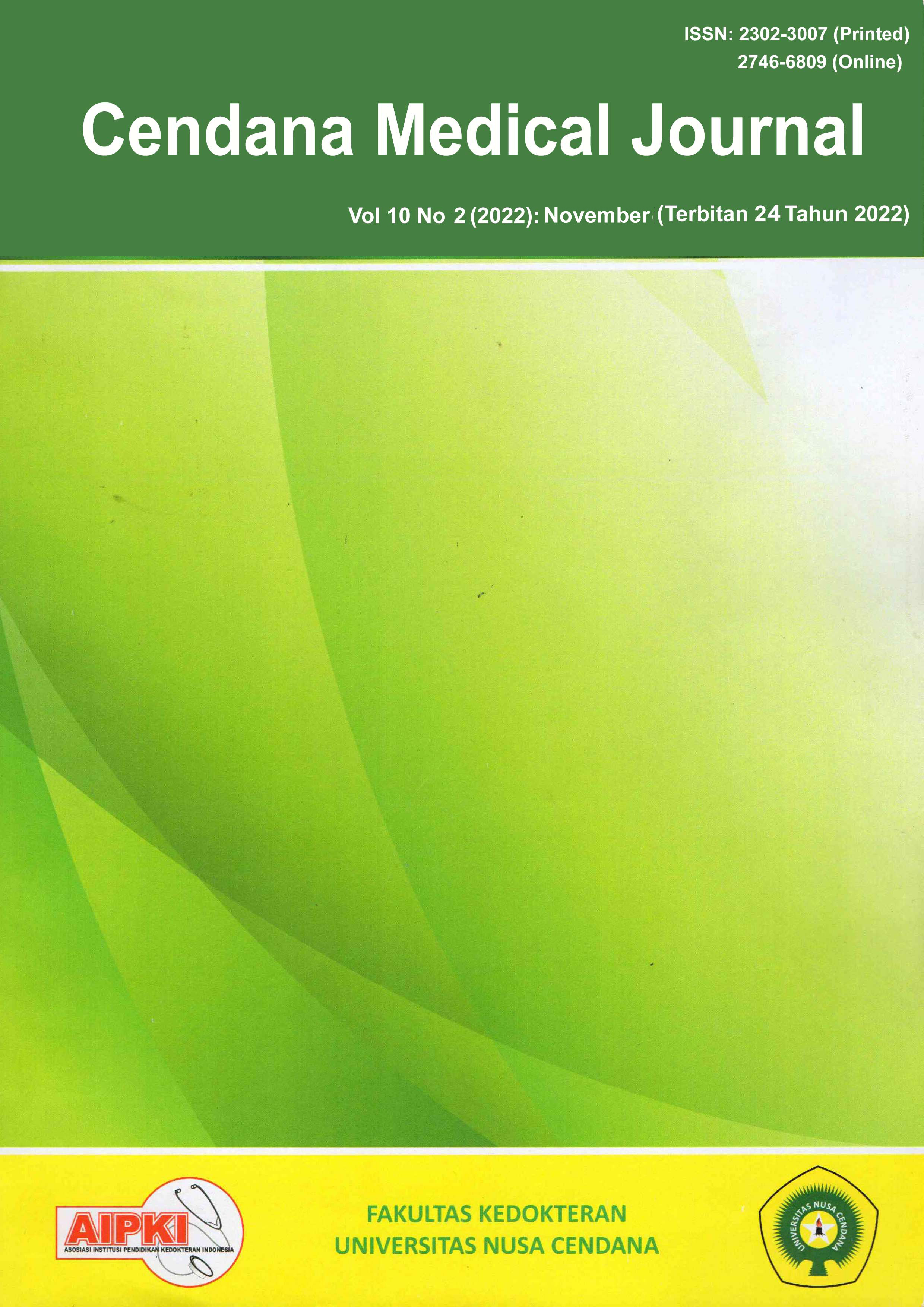TEST OF ANTIBACTERIAL ACTIVITY OF ETHANOL 70% EXTRACT KENCUR RHIZOMES (Kaempferia galanga Linn) ON Streptococcus pyogenes In Vitro
Abstract
Streptococcus pyogenes is a gram-positive bacterium that causes extensive infection, particularly in the respiratory tract and skin, also the 90% cause of pharyngitis cases encountered in the primary health care unit. Pharyngitis infections by S. pyogenes are treated with Penicillin G or other beta-lactam derivates, if left untreated or delayed may occur sekuele immunity, Acute Rheumatic Fever (ARF) that causes permanent damage to the heart valves or Rheumatic Heart Disease (RHD). Morbidity due to heart failure in RHD patient. In recent years there have been reports of resistance to antibiotic treatment in S. pyogenes infections cases. In East Nusa Tenggara, Kencur rhizomes (Kaempferia galanga Linn) is used for generations to cure complaints such as cough, flu, asthma, flatulence and abdominal pain. In accordance with previous research that proved Kencur rhizomes extract is an analgesic, anti-inflammatory, anti-helmintic, mosquito repellent, mosquito larvae growth inhibitor, vasodilator, anti-cancer, anti oxidant, sedative, anti-UVB and anti bacteria. The purpose of this research was to know the antibacterial activity of ethanol extract of kencur rhizome on S. pyogenes in vitro, effectiveness of Kencur rhizome extract as antibacterial and minimal concentration of Kencur rhizome extract which can inhibit the growth of S. pyogenes. The method of this research is True Experimental Research with Posttest Only Control Group Design as design. The sample of this study, used extract ethanol of Kencur rhizome which tested using the well diffusion method to observe the antibacterial activity prepare in eight concentrations (1 (100%), 2 (50%), 25%, 12.5%, 6.25%, 3.12%, 1, 56% and 0.78%), one positive control group (amoxicillin) and one negative control group (sterile aquadest) with three times replications. The results showed that the extract of ethanol Kencur rhizome has antibacterial activity but not effective as anti bacteria on the growth of S. pyogenes bacteria and the concentration 0.78% was determined as minimum inhibitory concentration.
Downloads
References
2. Westbroek ML, Davis CL, Fawson LS, Price TM. Interactions of Lactobacilli with Pathogenic Streptococcus pyogenes. Journal Infectious Diseases in Obstetrics and Gynecology. 2010;2010:1-3.
3. Direktorat Jenderal Bina Kefarmasian dan Alat Kesehatan Departemen Kesehatan Republik Indonesia. Pharmaceutical Care untuk Penyakit Infeksi Saluran Pernapasan. Jakarta: Departemen Kesehatan Republik Indonesia;2005. h.18-22.
4. Badan Penelitian dan Pengembangan Kesehatan Kementerian Kesehatan Republik Indonesia. Riset Kesehatan Dasar Tahun 2013. Jakarta: Kementerian Kesehatan Republik Indonesia;2013. h. 65-6.
5. Kumar S. Essentials of Microbiology. New Delhi: Jaypee Brothers Medical Publishers;2016. h. 179.
6. Camara M, Dieng A, Boye CSB. Antibiotic Susceptibilty of Streptococcus pyogenes Isolated from Respiratory Tract Infections in Dakar, Senegal. Journal Microbiology Insights. 2013;6:71–5.
7. Umar MI, Asmawi MZB, Sadikun A, Altaf R, Iqbal MA. Phytochemistry and Medicinal Properties of Kaempferia galanga L. (Zingiberaceae) Extracts. 2011;5(14):1638–47.
8. Hasanah AN, Nazaruddin F, Febrina E, Zuhrotun A. Analisis Kandungan Minyak Atsiri dan Uji Aktivitas Antiinflamasi Ekstrak Rimpang Kencur (Kaempferia galanga L.). Jurnal Matematika dan Sains. 2011;16:147–52.
9. Astuti Y, Sundari D, Winarno MW. Tanaman Kencur (Kaempferia galanga L.); Informasi tentang Fitokimia dan Efek Farmakologi. Warta Tumbuhan Obat Indonesia. 1996;(20):26.
10. Nag S, Mandal S. Importance of Ekangi (Kaempferia galanga L.) as Medicinal Plants. International Journal of Innovative Research and Review. 2015;3(1):99–106.
11. Gholib D. Daya Hambat Ekstrak Kencur (Kaempferia galanga L.) terhadap Trichophyton mentagrophytes dan Cryptococcus neoformans Jamur Penyebab Penyakit Kurap pada Kulit dan Penyakit Paru. Buletin Littro. 2009;20(1):59–67.
12. Rahayu DH. Uji Aktivitas Antibakteri Ekstrak Etanol Buah Takokak (Solanum torvum swartz) terhadap Pertumbuhan Staphylococcus aureus Secara In Vitro. [Skripsi]. Universitas Nusa Cendana:2016.
13. Kurniawati E. Daya Antibakteri Ekstrak Etanol Tunas Bambu Apus Terhadap Bakteri Escherichia coli dan Staphylococcus aureus secara in vitro. Jurnal Wiyata. 2015;2(2):193-99.
14. Setyowati WAE, Ariani SRD, Ashadi, Mulyani B, Rahmawati CP. Skrining Fitokimia dan Identifikasi Komponen Utama Ekstrak Metanol Kulit Durian (Durio zibethinus Murr.) Varietas Petruk. Dalam: Pemantapan Riset dan Asesmen Dalam Pembelajaran Berbasis Saintifik: Seminar Nasional Kimia dan Pendidikan Kimia VI; 21 Juni 2014; Surakarta. Surakarta: Program Studi Kimia dan Pendidikan Kimia Jurusan PMIPA FKIP UNS; 2014;6: h.271-80.
15. Sahputra A. Uji Eefektifitas Ekstrak Madu Karet dalam Menghambat Pertumbuhan Staphylococcus aureus. [Skripsi]. Universitas Islam Negeri Syarif Hidayatullah: 2014.
16. Rijayanti RP, Liliana S, Trianto HF. Uji Aktivitas Antibakteri Ekstrak Etanol Daun Mangga Bacang (Magitera foetida L.) terhadap Staphylococcus aureus Secara In Vitro. Jurnal Kesehatan Universitas Tanjungpura. 2014: h.10-3.
17. Soleha TU. Uji Kepekaan terhadap Antibiotik. Jurnal Kesehatan Universitas Lampung. 2015;5(9):119-23.
18. Patel J, Weinstein M, Eliopoulos G, Jenkins S, Lewis J, Limbago B, et all. M100 Performance Standards for Antimicrobial Susceptibility Testing. Wayne; Clinical and Laboratory Standards Institute: 2017; 27:85.
19. Fajeriyati N, Andika. Uji Aktivitas Antibakteri Ekstrak Etanol Rimpang Kencur (Kaempferia galanga L.) pada Bakteri Bacillus subtilis dan Escherichia coli. Journal of Current Pharmaceutical Sciences. 2017; 1(1): h. 38.
20. Hayati F, Mudatsir, Safarianti. Uji Aktivitas Antibakteri Ekstrak Etanol Rimpang Kencur (Kaempferia galanga L.) Terhadap Isolat Klinis Klebsiella pneumonia Secara In Vitro. Jurnal Ilmiah Mahasiswa Kedokteran Medisia. 2017; 2(1): h. 70-1.
21. Saraswati J, Septalita A, NB Arini. Antibacterial Effect of Kaempferia galanga L. Extract on Lactobacillus acidophilus-In Vitro. The Indonesian Journal of Infectious Disease. 2017; h. 25-6.
Copyright (c) 2022 Cendana Medical Journal (CMJ)

This work is licensed under a Creative Commons Attribution-NonCommercial-NoDerivatives 4.0 International License.
Copyright Notice

This work is licensed under a Creative Commons Attribution 4.0 International License.

 Megaputri Yoriska Ratu Edo(1*)
Megaputri Yoriska Ratu Edo(1*)












